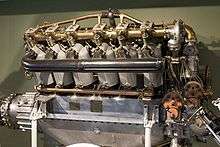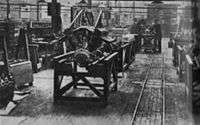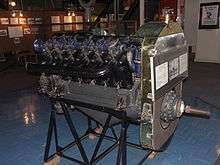Rolls-Royce Eagle
| Eagle | |
|---|---|
 | |
| Rolls-Royce Eagle VIII at the Canada Aviation Museum | |
| Type | Piston V-12 aero-engine |
| Manufacturer | Rolls-Royce Limited |
| First run | February 1915 |
| Major applications | Airco D.H.4 Vickers Vimy |
| Number built | 4,681 |
| Developed into | Rolls-Royce Falcon |
The Rolls-Royce Eagle was the first aero engine to be developed by Rolls-Royce Limited. Introduced in 1915 to meet British military requirements during World War I, it was used to power the Handley Page Type O bombers and a number of other military aircraft.
The Eagle was the first engine to make a non-stop trans-Atlantic crossing by aeroplane when two Eagles powered the converted Vickers Vimy bomber on the Transatlantic flight of Alcock and Brown in June 1919.
Background
At the outbreak of World War I in August 1914, the Royal Aircraft Factory asked Rolls-Royce to develop a new 200 hp air-cooled engine. Despite initial reluctance they agreed on condition that it be cooled by water rather than air, as this was the company's area of expertise.[1]
Design and development
Development of the new 20 litre engine was led by Henry Royce from his home in Kent. Based initially on the 7.4 litre 40/50 Rolls-Royce Silver Ghost engine, and drawing also on the design of a 7.2 litre Daimler DF80 aero engine used in a 1913 Grand Prix Mercedes that had been acquired,[2] the power was increased by doubling the number of cylinders to twelve and increasing their stroke to 6.5 inches, although their bore remained at 4.5 inches of the 40/50. The engine was also run faster, and an epicyclic reduction gear was designed to keep the propeller speed below 1,100 rpm. To reduce inertia and improve performance the valvetrain design was changed from sidevalves to a SOHC design,[3] closely following the original "side-slot" rocker arm design philosophy used on the contemporary German Mercedes D.I, Mercedes D.II and Mercedes D.III straight-six aviation powerplants.

On 3 January 1915 the Admiralty ordered twenty-five of the new engines. The Eagle first ran on a test bed at Rolls-Royce's Derby works in February 1915, producing 225 hp at 1,600 rpm. This was quickly increased to 1,800, then in August 1915 to 2,000 rpm where it produced 300 hp. After further testing, it was decided to approve the engine for production at 1,800 rpm and 255 hp; 1,900 rpm was allowed for short periods. The engine first flew on a Handley Page O/100 bomber in December 1915, the first flight of a Rolls-Royce aero engine.
The Eagle was developed further during 1916 and 1917, with power being progressively increased to 360 hp by February 1918 by which time eight versions had been produced. Throughout World War I Rolls-Royce struggled to build Eagles in the quantities required by the War Office, but the company resisted pressure to licence other manufacturers to produce it, fearing that the engine's much admired quality would risk being compromised.[4]
After the War, a Mark IX version of the Eagle was developed for civilian use. Production continued until 1928, and in total 4,681 Eagle engines were built.[5]
Time between overhaul (TBO) for later Eagles was around 100-180 hours.[6]
Variants
Note:[7]
- Eagle I (Rolls-Royce 250 hp Mk I)
- (1915), 225 hp, 104 engines produced in both left and right hand tractor versions.
- Eagle II (Rolls-Royce 250 hp Mk II)
- (1916), 250 hp, 36 built at Derby.
- Eagle III (Rolls-Royce 250 hp Mk III)
- (1917-1927), 250 hp, increased compression ratio (4.9:1), strengthened pistons. 110 built at Derby.
- Eagle IV (Rolls-Royce 250 hp Mk IV)
- (1916-17), 270/286 hp, 36 built at Derby.

- Eagle V (Rolls-Royce 275 hp Mk I)
- (1916-17), 275 hp, high-lift camshaft, 100 built at Derby.
- Eagle VI (Rolls-Royce 275 hp Mk II)
- (1917), 275 hp, first use of twin spark plugs, 300 built at Derby.
- Eagle VII (Rolls-Royce 275 hp Mk III)
- (1917-18), 275 hp, 200 built at Derby.
- Eagle VIII
- (1917-1922), 300 hp, extensive modifications, 3,302 built at Derby.
- Eagle IX
- (1922-1928), 360 hp, developed as a civil use engine, 373 built at Derby.
Applications
Engines on display
Examples of the Rolls-Royce Eagle are on display at the:
- Science Museum, London
- Canada Aviation Museum
- South African National Museum of Military History, Johannesburg
- South African Air Force Museum, Port Elizabeth
One of the two Eagles that powered Alcock and Brown's historic transatlantic flight is on display at the Derby Industrial Museum.[8]
Specifications (Eagle IX)
Data from Lumsden[9]
General characteristics
- Type: 12-cylinder liquid-cooled 60° Vee aircraft piston engine
- Bore: 4.5 in (115 mm)
- Stroke: 6.5 in (165 mm)
- Displacement: 1,239 in³ (20.32 L)
- Length: 72.6 in (1,844 mm)
- Width: 42.6 in (1,082 mm)
- Height: 46.4 in (1,178 mm)
- Dry weight: 900 lb (408 kg)
Components
- Valvetrain: Overhead camshafts
- Fuel system: Twin Claudel-Hobson carburettors
- Cooling system: Liquid-cooled
Performance
- Power output: 360 hp (268 kW) at 1,800 rpm
- Specific power: 0.32 hp/in³ (13.4 kW/L)
- Compression ratio: 5.22:1
- Fuel consumption: 24 gallons per hour (90 Litres per hour)
- Power-to-weight ratio: 0.40 hp/lb (0.66 kW/kg)
See also
- Related development
- Comparable engines
- Related lists
References
Notes
- ↑ Pugh 2001, p.71.
- ↑ Taulbot 2011, p.41.
- ↑ Pugh 2001, p.72.
- ↑ Pugh 2001, p.79-86.
- ↑ Lumsden 2003, p.183.
- ↑ "World Encyclopedia of Aero Engines - 5th edition" by Bill Gunston, Sutton Publishing, 2006, p.186
- ↑ List from Lumsden, alternate official designations in italics.
- ↑ Derby Industrial Museum - Eagle engine Retrieved: 3 August 2009
- ↑ Lumsden 2003, p.186.
Bibliography
- Lumsden, Alec. British Piston Engines and their Aircraft. Marlborough, Wiltshire: Airlife Publishing, 2003. ISBN 1-85310-294-6.
- Pugh, Peter. The Magic of a Name - The Rolls-Royce Story: The First 40 Years. Duxford, Cambridge: Icon Books, 2001. ISBN 1-84046-151-9.
- Rubbra, A.A.Rolls-Royce Piston Aero Engines - A Designer Remembers. Rolls-Royce Heritage Trust. Historical Series no 16. ISBN 1-872922-00-7
- Taulbut, Derek S. Eagle - Henry Royce’s First Aero Engine, Rolls-Royce Heritage Trust, 2011. ISBN 978-1-872922-40-9.
External links
| Wikimedia Commons has media related to Rolls-Royce Eagle. |